US jobs market report released today has completely changed the market outlook. This week's data were rather favorable for the Federal Reserve, which maintained its stance and continued to indicate a desire for interest rate cuts this year. Today's data likely pushes back the timing of these cuts, although upon delving into the details, we can notice some inconsistencies.
Strong employment growth
Start investing today or test a free demo
Create account Try a demo Download mobile app Download mobile appEmployment in the non-farm sector increased by 272,000. Today's reading was almost 100,000 higher than the market consensus, which projected a reading of 175,000. This is also significantly more than the ADP report. The NFP reading below ADP for April was an outlier, as for many months ADP had been underestimating the NFP reading. It's also worth noting that the NFP reading fits into a "plateau" in terms of monthly employment changes. There is no visible trend, as was the case in 2021, 2022, and the first part of 2023. It more closely resembles the pre-COVID years, where readings fell within the range of 150,000-250,000. Currently, this range is just slightly higher.

Strong wage growth
While the increase in employment does not necessarily translate into higher inflationary pressure, higher wages certainly have a positive impact on price growth. After several months of continuous declines, we are observing a fairly significant rebound in wage growth dynamics. On an annual basis, we see a rebound to 4.1% year-on-year from 3.9% year-on-year. On a monthly basis, this dynamic is already 0.4% month-on-month, compared to the previous reading of 0.2% month-on-month. Although the trend in wages remains downward, the dynamic is moving away from the desired level of +/- 3.0% annually, which would be consistent with the Fed's inflation target. Further readings above 4% could change the perception of the restrictiveness of monetary policy, especially since the Fed places great emphasis on core inflation.
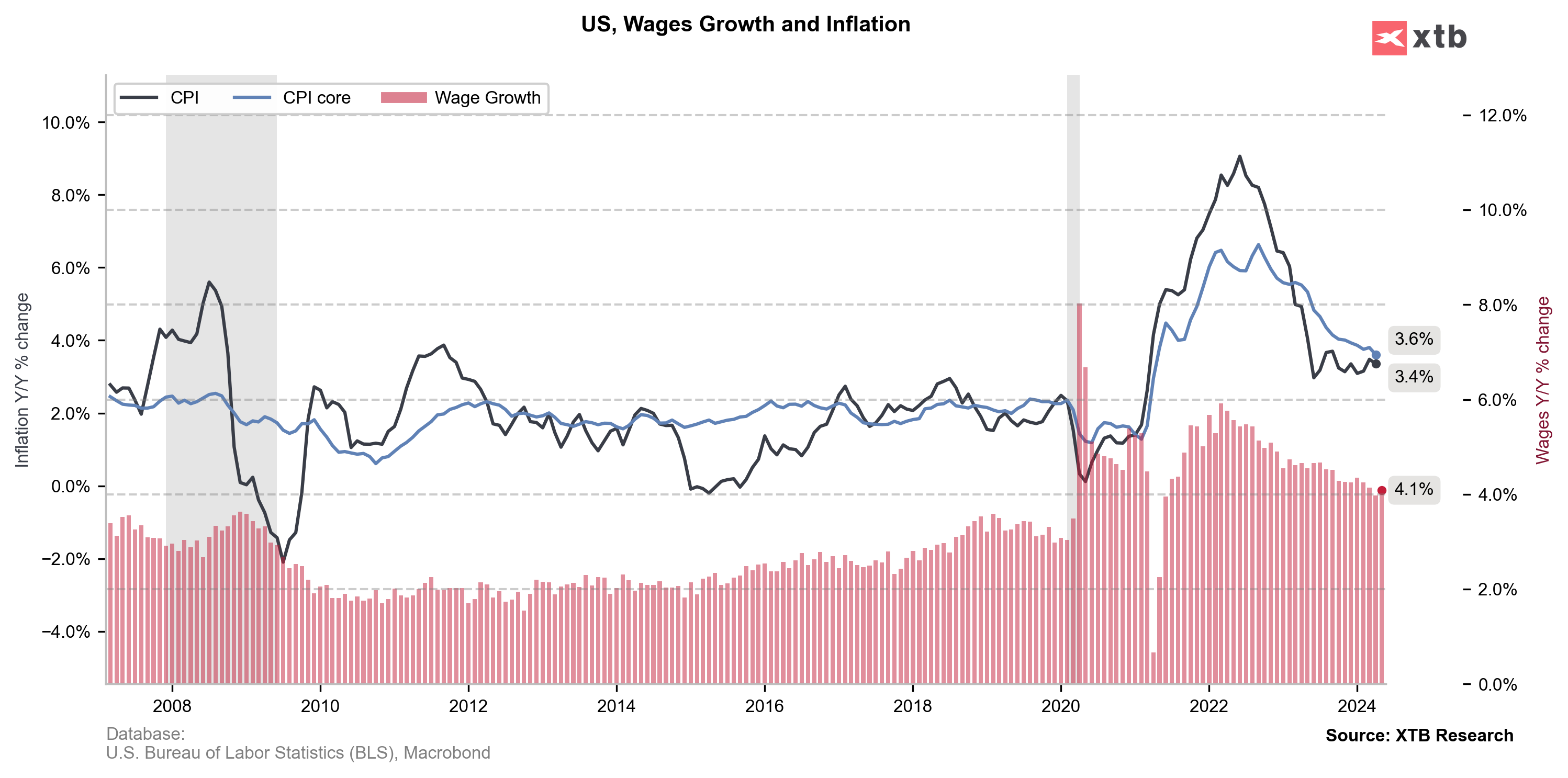
Declining job demand?
It is also worth noting another issue. The latest JOLTS report showed another significant decline in job openings. Job openings fell to about 8 million. This is much less than the peak of 12 million but higher than the pre-pandemic level of about 6-7 million. On the other hand, looking at the trend from 2010-2020, the current number of openings seems relatively small, yet employment continues to rise. While there may be a slight cooling in the labor market, it is certainly not one that could lead to a collapse in employment.
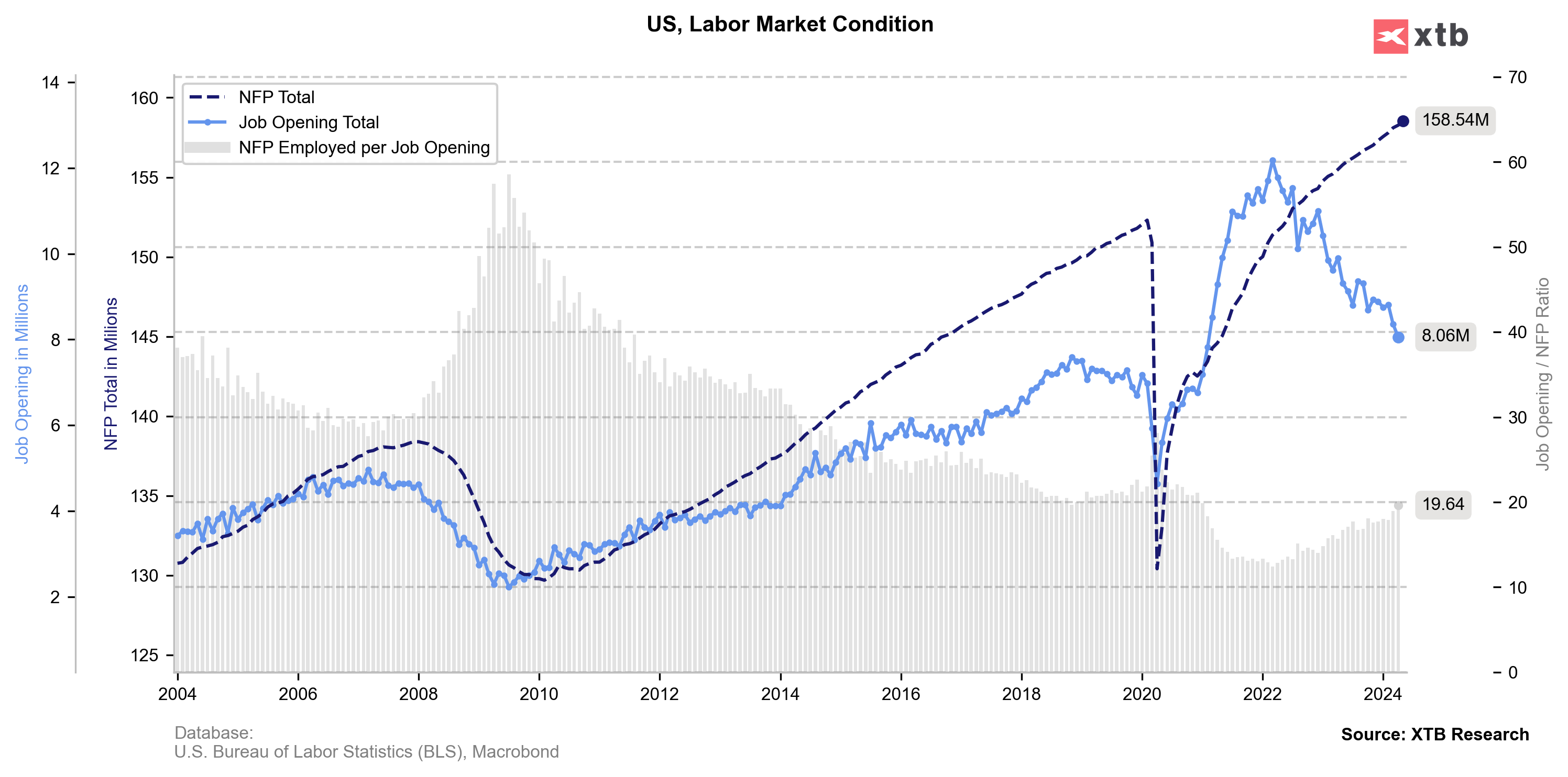
Higher unemployment rate
Interestingly, amidst all this, the unemployment rate has rebounded to 4.0%, which is the level expected by the Fed. However, the labor force participation rate fell by 0.2 percentage points to 62.5%. This is not a recessionary signal, but it is worth noting.
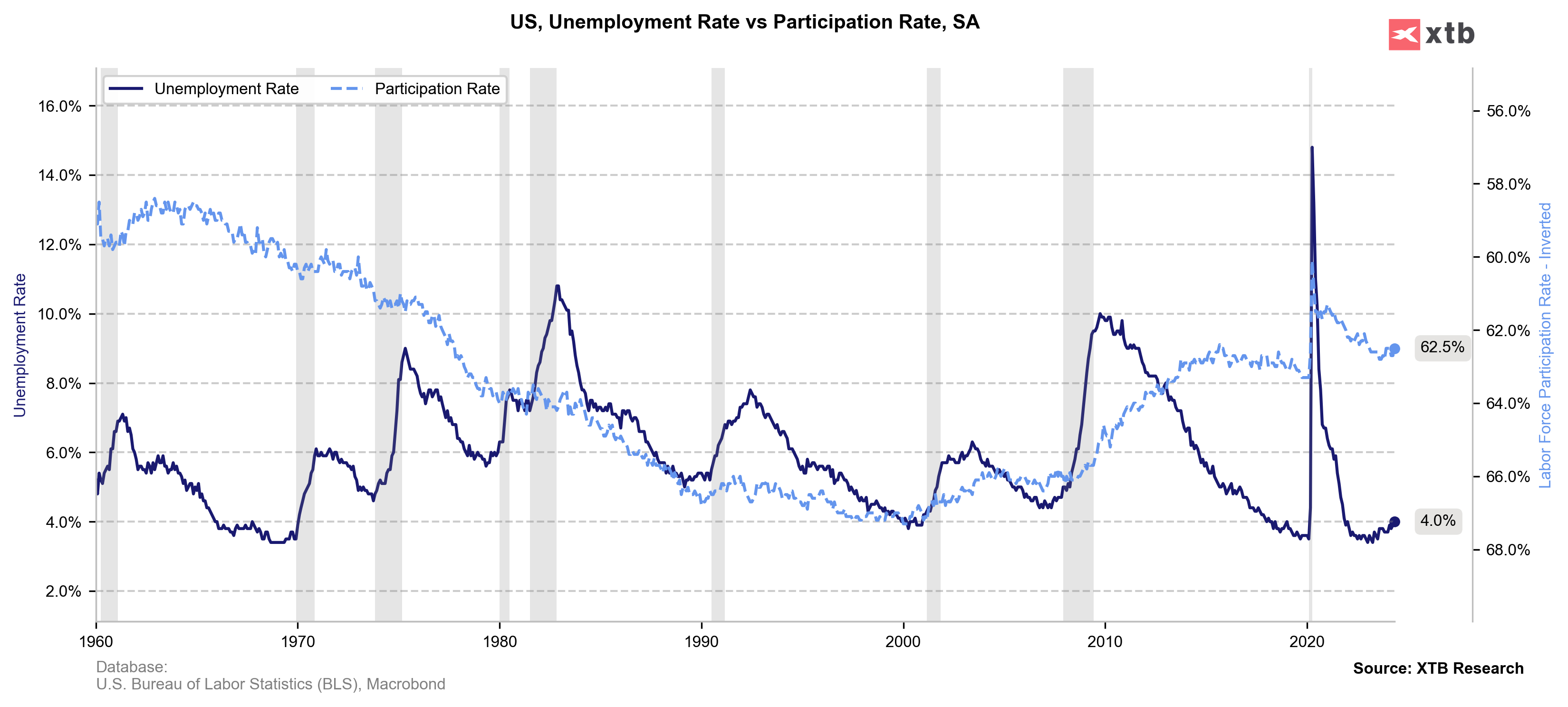
Significant discrepancy in reports
For some time, there has been talk of a significant discrepancy between the NFP report (business surveys) and the household survey report (from which the unemployment rate is derived). According to the household survey, employment fell by over 400,000 in May! Of course, it is worth remembering that the NFP report is the result of a model in which the adjustment factor for births and deaths plays an increasingly significant role. Nonetheless, the disparity is very large. On one hand, we have a very strong labor market with another strong increase in employment and wage growth, and on the other, a significant drop in the number of employed. Which better reflects the state of the economy?
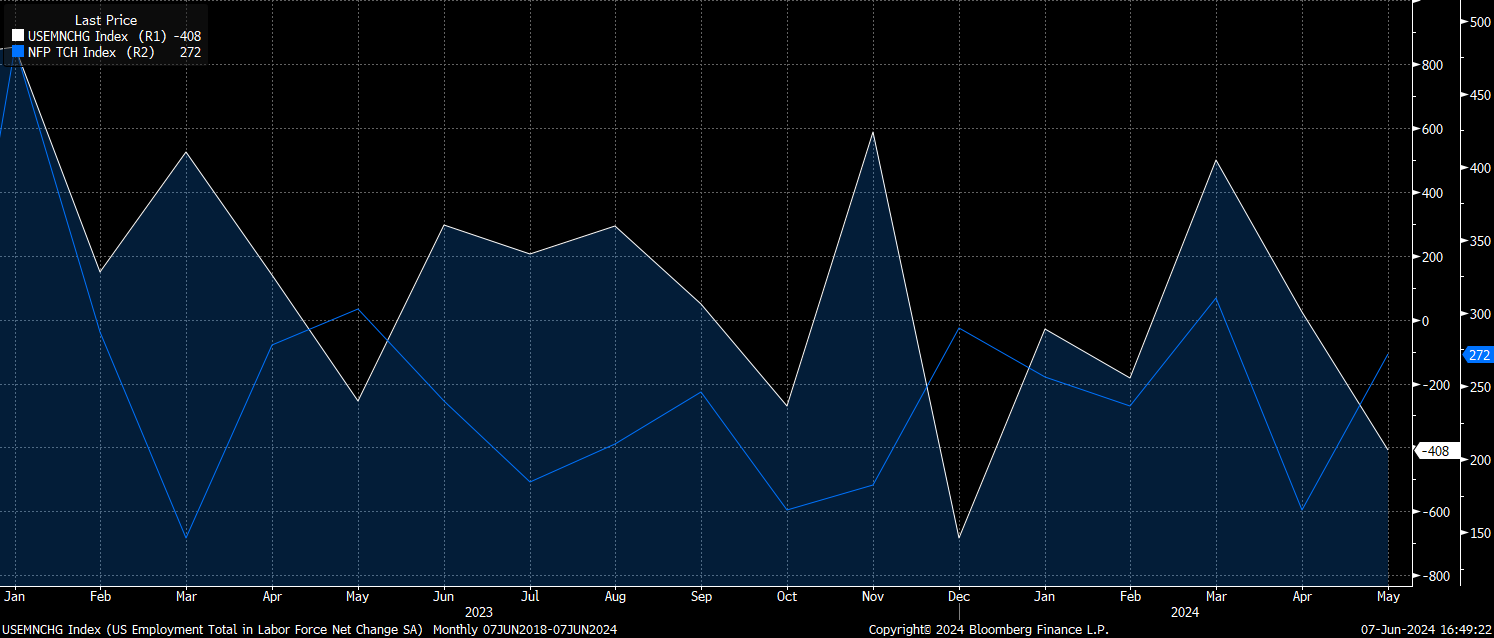
What does the report mean for the Fed?
Had it not been for the wage growth, the report likely would not have changed much in the perception of the state of the labor market. The Fed looks at many indicators, but even if we were to see a decline in employment in the NFP report in June, a rate cut in July is practically impossible. September will likely remain in play, although it will depend on inflation readings. Nevertheless, the report is likely to lead to a sustained rebound in bond yields, which will remain high in the long term. The Fed is likely to make significant changes to the expected interest rates (dot-chart), which could impact Wall Street and the US dollar.
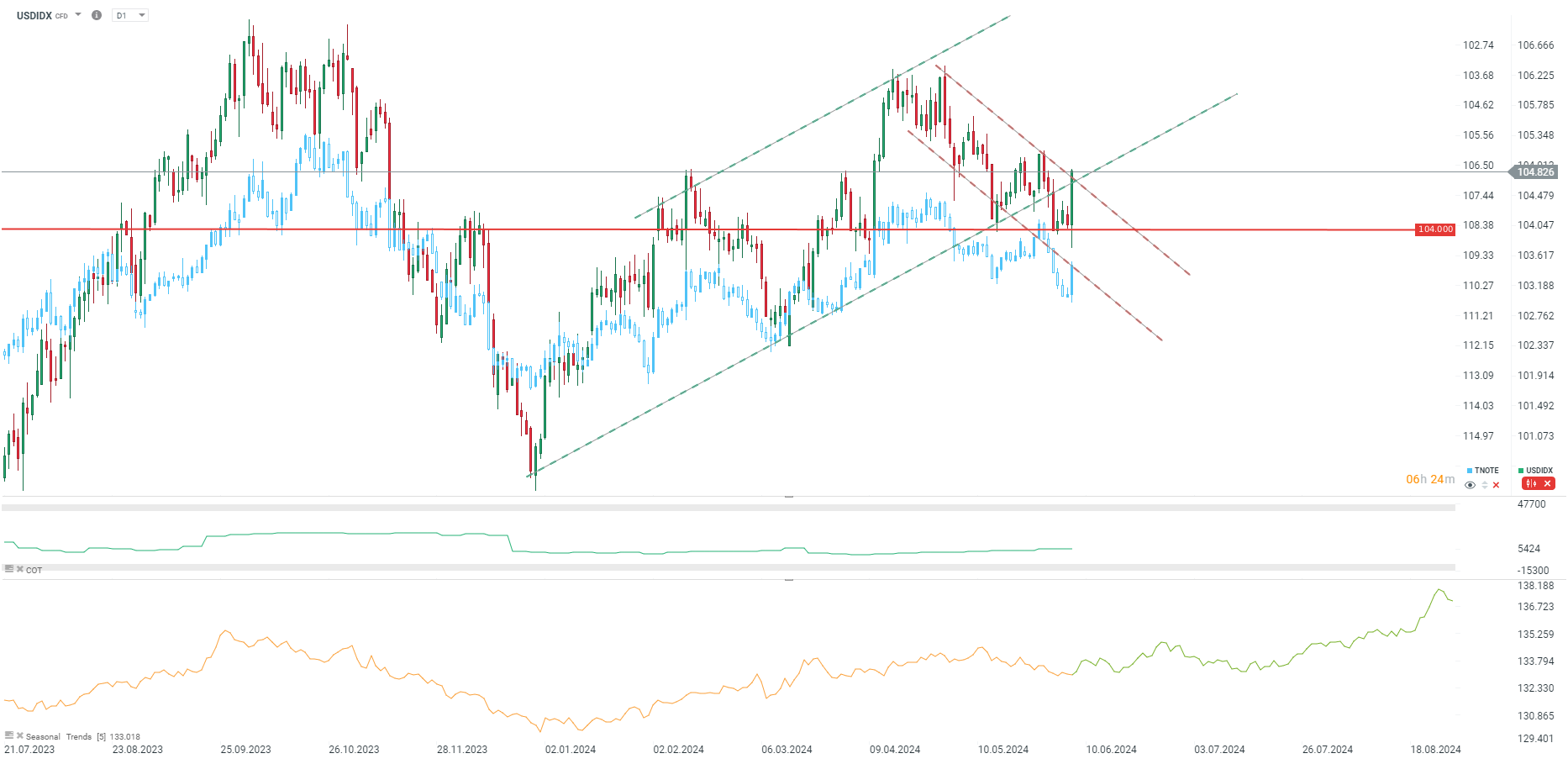
US dollar index (USDIDX) defended important support in the 104.00 area. If yields return to the level of 4.5% or higher, testing the levels of 105-106 in the next 4-8 weeks cannot be ruled out. Source: xStation5
The content of this report has been created by XTB S.A., with its registered office in Warsaw, at Prosta 67, 00-838 Warsaw, Poland, (KRS number 0000217580) and supervised by Polish Supervision Authority ( No. DDM-M-4021-57-1/2005). This material is a marketing communication within the meaning of Art. 24 (3) of Directive 2014/65/EU of the European Parliament and of the Council of 15 May 2014 on markets in financial instruments and amending Directive 2002/92/EC and Directive 2011/61/EU (MiFID II). Marketing communication is not an investment recommendation or information recommending or suggesting an investment strategy within the meaning of Regulation (EU) No 596/2014 of the European Parliament and of the Council of 16 April 2014 on market abuse (market abuse regulation) and repealing Directive 2003/6/EC of the European Parliament and of the Council and Commission Directives 2003/124/EC, 2003/125/EC and 2004/72/EC and Commission Delegated Regulation (EU) 2016/958 of 9 March 2016 supplementing Regulation (EU) No 596/2014 of the European Parliament and of the Council with regard to regulatory technical standards for the technical arrangements for objective presentation of investment recommendations or other information recommending or suggesting an investment strategy and for disclosure of particular interests or indications of conflicts of interest or any other advice, including in the area of investment advisory, within the meaning of the Trading in Financial Instruments Act of 29 July 2005 (i.e. Journal of Laws 2019, item 875, as amended). The marketing communication is prepared with the highest diligence, objectivity, presents the facts known to the author on the date of preparation and is devoid of any evaluation elements. The marketing communication is prepared without considering the client’s needs, his individual financial situation and does not present any investment strategy in any way. The marketing communication does not constitute an offer of sale, offering, subscription, invitation to purchase, advertisement or promotion of any financial instruments. XTB S.A. is not liable for any client’s actions or omissions, in particular for the acquisition or disposal of financial instruments, undertaken on the basis of the information contained in this marketing communication. In the event that the marketing communication contains any information about any results regarding the financial instruments indicated therein, these do not constitute any guarantee or forecast regarding the future results.

